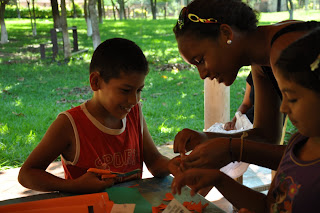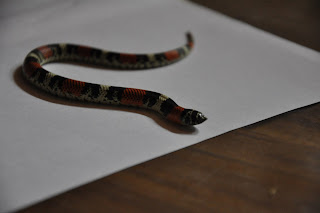The eating schedule is really different here than in America. Most people don’t eat breakfast, but if they do they have chipa or cocido. Then there’s mediamañana at around 11, which is a salty midmorning snack. This is usually a sandwich or empanada. Next is lunch at around 1 or 1:30, which is the biggest meal of the day (dinner and lunch are the opposite of how we eat in the US). For lunch my mom usually cooks pasta, rice or beans with beef (either diced, or in a big chunk) with a sauce made of oil and tomatoes and various other ingredients all blended into a liquid. On rainy days we usually have soup for lunch. At around 4 sometimes we have merienda, but not always. This is a sweet midafternoon snack. It’s usually cocido with dulce de leche on bread. Dinner is between 9 and 10. My mom doesn’t cook for dinner, so we usually buy empanadas or burgers or pizza or sometimes we make toasted ham and cheese sandwiches or tortillas. The diet in Paraguay mainly consists of meat and carbs. In my house, we hardly ever eat whole grains. Fresh vegetables and fruits are viewed as a special treat because they're expensive. This diet doesn't have much nutritional value, but it does taste good! One of my favorite things about Paraguay is all of its traditional foods. At this website you can find recipes (in english!) for most of the foods. Here are the most common ones (sorry I don't have pictures for all of them):

Chipa:
This is a bready snack or breakfast food. It comes in lots of different shapes and sizes (the chipa pictured is in a “medialuna” half moon shape). Chipa tastes kind of like a cross between a soft pretzel and a biscuit. People sell it everywhere—in the streets, on buses and outside of school. They carry it in big baskets on their heads. There are also things called “chipa barreros” which are trucks that drive around with megaphones hawking chipa (and waking me up in the morning). It is traditional to make chipa during Semana Santa (I talked about this in my last post).
Cocido:
This is a drink made from Yerba, water and sugar. It’s kind of like tea, and usually mixed with milk. To make it, you heat sugar in a pot until it’s brown and liquidy, then add water and stir until it’s mixed. Then you add yerba leaves and boil.

Sopa Paraguaya:
This is traditional Paraguayan bread/casserole dish. It is served almost every day with lunch, but it is eaten as a snack too.
Empanadas:
These are little pockets of dough filled with chicken, ground beef, ham and cheese, or corn then fried. I have an empanada at least once a day. They are eaten for snack, but also sometimes for dinner. People sell them in front of their houses everywhere and on any block there are at least five places to buy them. They’re also sold at my school’s cantina, and all of my classmates buy them there for their mediamañana snack. My favorite type is carne, which is ground beef mixed up with diced hardboiled eggs.

Mandioca:
In the US this is known as Yucca Root. We have it every day with lunch and often with dinner too. Its taste is kind of like a potato, with a little more texture. It’s pretty bland so it’s usually eaten with a bite of meat. It’s prepared by taking off the skin and then steam cooking it. I’ve had fried mandioca and mandioca empanadas a couple of times, but it is usually just eaten alone, not as an ingredient.
Dulce de Leche:
This is caramel. It can be eaten on top of ice cream or cake, as an ingredient in deserts, or (my preferred method) alone with a spoon. In my dad’s store he has these huge barrels filled with it, so every week he brings a big bowl home for us. It’s very popular here and even has its own aisle in the grocery store because people eat it so much!

Alfajors:
These are little sandwich cookies with a cakey outside and dulce de leche in the middle. Sometimes the edges are rolled in coconut. There are also packaged alfajors sold in stores and in my school’s cantina. These usually have three cookie layers and two dulce de leche layers and are coated in chocolate on the outside. Sugar overload!
Chipa Guazu:
This is a lot like Sopa Paraguaya, but with corn. It reminds me of corn casserole in the United States. It’s usually eaten as a side with lunch, instead of sopa paraguaya.

Tortillas:
These are very different from the tortillas I’m used to in the US. They’re made from dough of eggs, flour, water and salt and then fried in a pan. Sometimes we also dice potatoes and put them in the dough. We make them for dinner.

Asado:
This is meat from the grill. It’s typically eaten for lunch on Sundays or at fiestas. Usually there’s sausage, ribs, chicken, and other types of meat. The first time I had it, I was surprised because it’s eaten with all of the fat still on the meat, making it really chewy. It’s good but I’m glad we only eat it once a week, because it is very filling.

Fish:
(Sorry, I forget the name!) This is grilled fish covered in a salsa of onions and peppers and tomatoes. We have it on Sundays sometimes, instead of Asado. The fish is usually a Dorado fresh from the Rio Paraguaya. The salsa is diced peppers, onions and tomatoes with a little bit of oil and salt. We put the salsa on top and my dad grills it until it’s super tender and it falls of the bone when you cut it. It is one of my favorite foods here. The only downside is that it has tons of little bones that you have to be careful to take out while you’re eating.





























